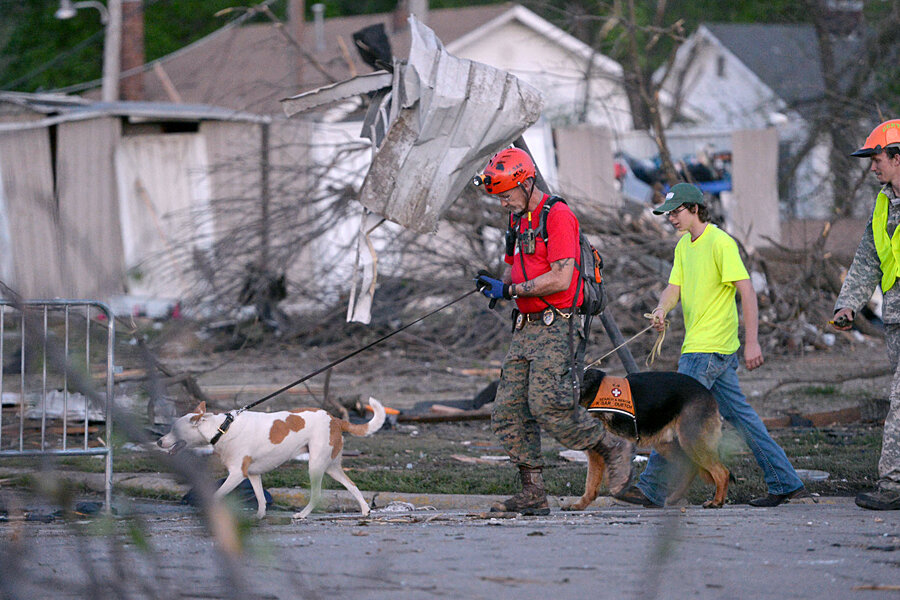Tornado rescue and recovery in full swing, even as more storms loom
Loading...
The sheer breadth of damage from two days of tornado strikes in the Southeast, plus the continued threat of thunderstorms and more tornadoes, is complicating rescue and recovery operations, even as drinking water, aid, and manpower begin to pour into devastated communities.
Search and rescue efforts are “going full bore now” in 20 Mississippi counties, including hard-hit Winston County, near Louisville, says Greg Flynn, spokesman for the Mississippi Emergency Management Agency (MEMA).
But weather forecasters expect this same area of the country to be pummeled by more storms after lunchtime Tuesday and into the evening, so “we’re very concerned with so many things already damaged and weakened, we really need for folks to remain weather-aware,” he adds.
The sprawling and deadly storm front that threatened mayhem across nearly a third of the US on Monday continues to be a force Tuesday, requiring thousands of tragedy-struck Americans clearing rubble from their communities to stay on high alert.
On Sunday and Monday, nearly 100 tornadoes hit in six states, killing at least 30 people in Oklahoma, Arkansas, Mississippi, and Alabama. Hundreds of others were hurt as powerful winds ripped apart trailer parks and gas stations. Images from the devastation poured onto Internet social networks such as Twitter, and a video went viral of a Tupelo, Miss., weatherman ordering TV station employees into the basement as a tornado bore down.
As the National Weather Service had predicted, the storm system shaped into the worst of a season that until now has been remarkable for the lack of death and injury.
The hardest-hit states have launched broad and dramatic search and rescue efforts. The Arkansas National Guard has 59 personnel, 24 Humvees, and a Blackhawk helicopter scanning Franklin County after local officials pleaded for help. (Tragically, one off-duty National Guardsman lost his life in the storm, and the Pentagon is reporting that National Guard family members have also been injured.)
"These are Arkansans helping Arkansans, like they always do – neighbor helping neighbor in a time of need," said Arkansas Gov. Mike Beebe.
Mississippi Gov. Phil Bryant on Tuesday called up 50 more National Guardsmen, making a total of 100 working the storm-struck area, all of whom are primarily combing the Tupelo and Louisville areas. Mississippi state emergency officials bused in a mobile emergency room to replace a damaged hospital in Louisville. The mobile emergency room was busy treating injuries, says Mr. Flynn.
In Alabama, the National Weather Service prepared Tuesday to deploy several storm assessment teams across the northern part of the state. Early reports suggest that the NWS did a good job of predicting tornado red zones and getting warnings issued, which probably saved lives.
"Almost everything we issued a tornado warning on last night had damage, if that gives you any kind of idea," Shelly Amin, a meteorologist in the Huntsville office, told the Huntsville Times.
Meanwhile, teams from large relief groups such as the American Red Cross were joined by smaller teams of volunteers marching into storm-struck areas. Convoy of Hope, a Missouri nonprofit group, is marshaling volunteers and donations to transport food and water to hard-hit spots in neighboring Arkansas.
"First thing folks need in a situation like this is food and water," Convoy of Hope’s Jeff Nene tells Arkansas Matters. "So we'll get food and water into that area as quickly as we can. Follow that up with cleaning supplies, possibly debris removal teams."
Concerned about the safety and welfare of children in storm-struck communities, Save the Children has dispatched a response team, which arrived in Mississippi on Tuesday. The nonprofit group’s staff is assessing how children in shelters are doing, and making sure care is available in what the group calls “child-focused disaster response.”
Georgia Gov. Nathan Deal declared emergencies even before the storms arrived in the state Tuesday morning, clearing the way for federal recovery dollars to be made available if tornados stray into the state. Eighty-nine counties are under heavy storm watches Tuesday.
“Your country will be there to help you recover and rebuild as long as it takes," President Obama said Monday.
The US government is on high alert as incident managers from the Federal Emergency Management Agency (FEMA) began arriving in state capitals on Tuesday to calibrate the federal response, which will focus more on long-term rebuilding. Those incident managers, however, have the ability to get needed resources to the front lines, if required.
On Sunday, Arkansas' Faulkner County was crushed by a suspected tornado that struck the towns of Vilonia and Mayflower, killing at least 15 people, including two children. One person died in a twister that slugged Quapaw, Okla., and as many as 20 businesses were destroyed in Baxter Springs, Kan., as part of the same localized outbreak.
Rescue personnel estimated the Baxter Springs tornado to be about three blocks wide as it mowed through the central business district in the town of 4,200.
Parts of Mississippi took the brunt of the storm on Monday, with at least eight casualties in and around Tupelo. Mississippi Gov. Phil Bryant said the twisters inflicted "severe damage" around Louisville.
Meanwhile, local rescue workers and National Guardsmen descended on debris-filled areas to search for survivors. In Mississippi, rescue workers are relying on locals to come up with lists of the missing – using what Flynn at MEMA calls “small town social networks.”
Monday night, thousands across the region were hunkered down in basements or out looking for tornado-scattered belongings. Electrical power in many areas is piecemeal, given the large numbers of trees that are down. Some who had power took to social media to document damage and record their emotions and pleas.
“Mass damage to the town, pray/send help in coming days,” read a storm tweet from Matt Coker, an Arkansas resident who witnessed the Mayflower tornado.








